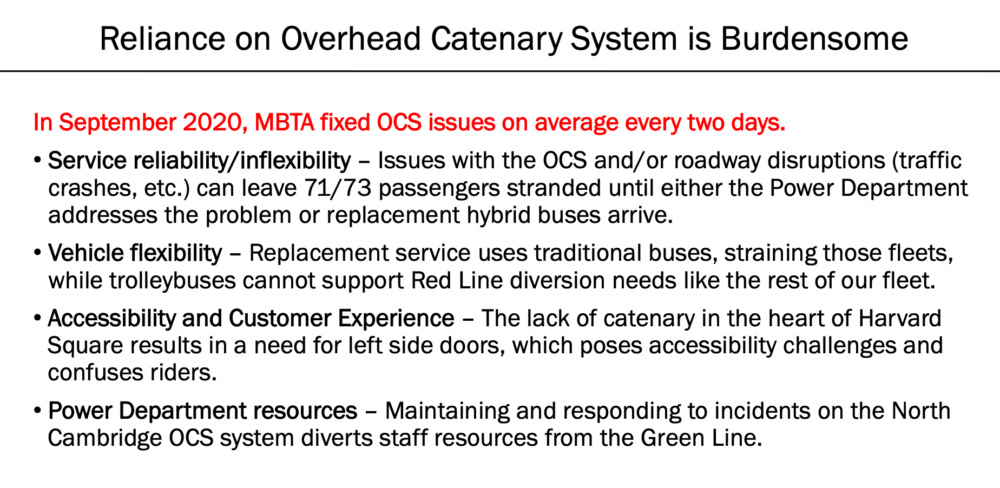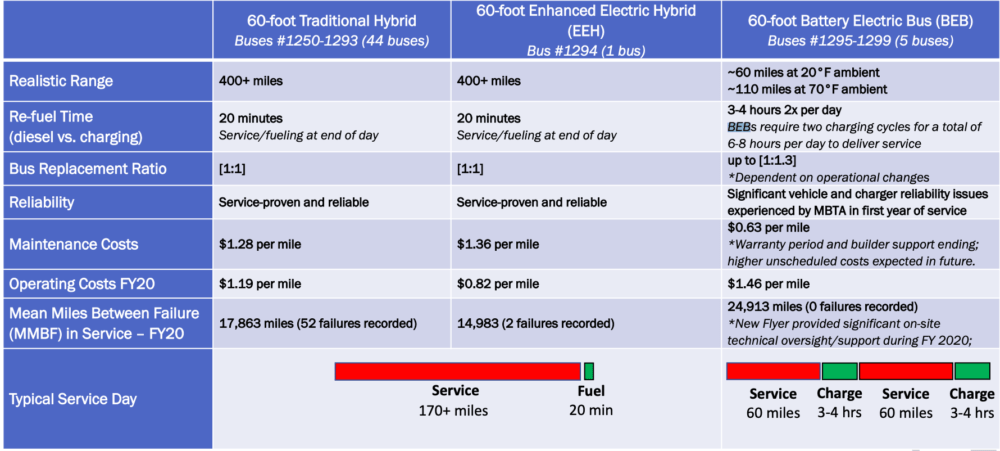Advertisement
Transit Expert Calls The MBTA’s $89M Plan For New Silver Line Buses ‘Greenwashing’

Shortly before Thanksgiving, the MBTA's Fiscal and Management Control Board decided to replace 32 aging Silver Line buses with 45 so-called "enhanced electric hybrid" (EEH) buses. The $89 million purchase is part of the MBTA's bus modernization program, which aims to give "better, faster, lower-emissions service."
“This bus has proven to be very reliable and capable of operating with zero emissions in the Silver Line tunnel along with other areas in the service network,” Bill Wolfgang, the MBTA’s director of vehicle engineering, said at at a recent public meeting. He added that the buses "provide a viable bridge" to a future when the entire bus system can be fully electric.
Local transit expert Ari Ofsevit is on board with improving buses and bus service, but says he thinks the MBTA's decision to buy these specific buses is misguided and actually not that climate friendly.
Ofsevit, a senior associate at the Institute for Transportation and Development Policy and a board member of the regional advocacy group TransitMatters, spoke to Earthwhile about why he thinks the buses are a bad choice for the region.
Highlights from this interview have been lightly edited for clarity.
Interview Highlights
To start, can you give me a primer on the different types of buses the MBTA uses?
The MBTA traditionally used diesel buses, but in the past 20 years, it’s been moving toward something called diesel-hybrid buses. Diesel-hybrid buses have a relatively small battery pack that drives the bus wheels, and a diesel engine to power that battery pack. The hybrid model allows a bus to actually operate much more efficiently because instead of always having to run the diesel engine, it can shut it off when it's stopped or when it's coasting, and use power more evenly when it’s accelerating.
The MBTA also has two types of electric buses. The first is an electric trolleybus, which are the buses with the poles on top like what you see in Harvard Square, Belmont and Watertown. These buses run on wires and use electricity, so they have zero local emissions.
The other part of the electric bus fleet are called diesel-electric buses. They run on trolley poles part of the time and a diesel engine the rest of the time. The Silver Line buses that run from the Seaport to the airport are an example of this — they’re electric in the tunnel because there’s not proper ventilation for diesel emissions, but then they switch to diesel when they reach street level.
Advertisement
What about buses that run on batteries, like a Tesla?
In the last 15 years, there have been significant improvements in electrification for buses, and we are moving toward a time where we will have battery buses — buses with a large battery that gets charged overnight and then uses that power on the routes.
Those batteries, in theory, can power the bus for a couple hundred miles of service. In practice, though, they use a lot of power just to maintain cabin temperature. The MBTA tested some battery buses in recent years and found that they have some shortcomings in range; buses that were supposed to get 150-200 miles per charge were getting only 50-100 miles.
Okay, so let’s turn to the Silver Line. You wrote an op-ed recently criticizing the MBTA’s plan to revamp this bus line — tell me about that.
The Silver Line buses are in pretty dire need of replacement. Buses usually last about 12 years, and some of these are 15 or 16 years old and getting pretty beat up. When buses get beat up, things start to fail — sometimes in the middle of the road — and maintenance costs go up.
Recently, the MBTA approved a contract to replace 32 diesel-electric buses with 45 “enhanced electric hybrid buses.” This sounds really good because you hear “electric” and “hybrid,” but EEH buses are really the same diesel buses that they have been buying for the last 15 years, just with a large battery pack.
If they'd come out and said, 'These are diesel buses with extended-range batteries,' that would have been a lot less of an issue. They literally just stripped diesel out of the name of the vehicle; this is what I meant when I called the plan “greenwashing.”
These buses still use diesel power for nearly all of their propulsion, but they can operate for short distances on a diesel-charged battery when they’re in places that don’t have good ventilation, like the tunnel in South Boston.
So I feel like EEH buses a pretty kludgy solution because we already have overhead electric power in the tunnel. With different buses, the MBTA could use the existing system to power buses in the tunnel and charge batteries. There are a lot of potential ways to electrify a bus fleet.
Like what?
When you have relatively dense bus routes all using the same corridor before fanning out — like many of the MBTA bus lines do — you could have a system where buses use the overhead wires in that corridor and then switch to battery power for the rest of the route. These buses, instead of having to sit at a terminal point for 10 or 15 minutes to recharge their batteries, could recharge “in motion” on the electrical wires.
But hasn’t the MBTA said it wants to move away from overhead wires because they are difficult to maintain?
Yes, when the MBTA looked at what to do with the existing overhead wire network their answer was basically, we don't want to use it because it's hard to maintain. I will add, though, that the MBTA has been maintaining overhead electric wire literally since 1889.
That led to the decision to try the battery buses, which as we previously discussed, weren’t suitable. And then that led them to look at these EEH buses.
I don't understand why these EEH buses are somehow less expensive than just buying new electric buses that can use the existing infrastructure. Maintaining existing infrastructure is generally the most efficient way to do things, so the fact that the MBTA seems to not want to do that is perplexing.

In deciding to buy 45 EEH buses, the MBTA projects that they will save 195,611 gallons of fuel over the lifecycle of the buses and reduce greenhouse gas emissions by 3,898 tons. That sounds pretty good, no?
So basically, my contention is that any time we buy a bus, or any time people are on a bus, it's a good environmental outcome because those are people who aren't driving in cars. But there are two problems with the enhanced electric hybrid. The first is a branding issue.
These are diesel buses and they're being sold as a step forward, when really, they’re really not. Right now, depending on the route, about 25-30% of the Silver Line is run on overhead electric power. What these enhanced diesel buses will do is make that 0% percent. The whole route will be run on diesel power, they'll just have a large battery that allows them to operate in the tunnel without turning the diesel engines on.
So yes, they'll use less fuel than the old existing buses, but the MBTA could replace the current fleet with the latest models of the same diesel-electric bus and save gas because any new bus is significantly more fuel efficient than an old bus. The new buses are still diesel buses. If the MBTA instead used all-electric buses which charged off the existing infrastructure, it could reduce diesel fuel consumption to zero.

The other issue I have with the EEH buses is about environmental justice. When the buses come out of the tunnels in East Boston and head to the airport and Chelsea, they will be running on diesel — in fact, they're going to be working overtime to charge the batteries so that when they go back into the tunnels to the Seaport they don't pollute there. These areas already have big air pollution problems and high asthma rates because of all the traffic and the airport.
The MBTA says it might be able to shut the engine off in certain parts of Chelsea to reduce very localized emissions, but then they'll actually have to run more in other parts of the route to generate the power for those batteries. It's like building a [dirty] power plant in Chelsea or East Boston, where most residents are people of color, and then shipping the electricity to the Seaport, where most residents are white.
So the MBTA recently announced they were going to buy these EEH buses, is there still time for agency leaders to change their minds?
Well, they have gone to the equipment maker and said we would like to buy 45 buses. Bus procurement takes about a year, and theoretically, they could probably go to the builder in a couple of months and say we would still like these 45 buses, but we'd like them to be built with different technology. But I wouldn't get my hopes up for that.
What I would hope is that this is the last all-diesel bus procurement that the MBTA makes. I would hope that they really go back to the drawing board on electrification and look at what the best technology is going forward for the whole system.
